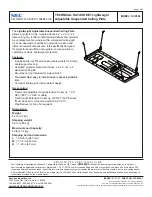
26
4.2
Iris
The HD-IVS has an iris inside the IVS lens. It is automated in such a way,
that the CCD sensor receives just the right amount of light in order not to
be overexposed. By this, the electronic amplification of the image (gain)
can be minimized. This avoids noise in the video image.
Only a relatively small portion of the light which passes through the film
camera’s lens reached the CCD-Chip of the video assist, as the light is
shared between the view finder, the CCD-Chip and the film. Therefore, the
normal operation mode is with the iris fully open and the different
exposure levels are compensated by the electronic gain. Only for special
applications in which a lot of light is used, e.g. motion effects, the light
level exceeds the range for electronic gain. In this case the motor closes
the iris.
In manual gain control mode (MGC on) neither the electronic gain nor the
iris changes, unless the keys MGC+
Ê
or MGC-
Ë
are used. First the
electronic gain is reduced. Only if the electronic gain is all the way down
will the iris close.
In automatic gain mode (MGC off) it works the same way. First the
electronic gain is reduced, and then the iris will stop down.
To avoid noise from the iris motor interfering with sound recording, the
IVS lens motor will not move when automatic gain is selected (MGC off)
and the camera runs at speeds between 21 FPS and 35 FPS.
No mechanical adjustments can be made for the iris.
4.3
Alignment of the Image Position (X-, Y- and Rotation)
The position of the image on the CCD-Chip and its focus can vary slightly
from camera to camera. The video image on the monitor may appear not
centered, rotated or out of focus.
Содержание K2.47050.0
Страница 1: ...1 HD IVS for ARRICAM ST K2 47050 0 Instruction Manual May 18th 2010 K5 40803 0 0035 64 00 00 01 K7601 ...
Страница 3: ...3 1 Quick Reference ...
Страница 4: ...4 MENU EDIT TEXT ...
Страница 9: ...9 2 3 Declaration of Conformity ...
















































